HKM History
2022
To celebrate the 60th anniversary of the Chinese Culture University, we organized the “60th Anniversary of the Chinese Culture University: Draft Paintings from the Hanyutang School” special exhibition. This was the first special exhibition exhibiting more than 2,000 of the works of Pu Xin-yu and his students. Additionally, we published the exhibition catalogue 60th Anniversary of the Chinese Culture University: Draft Paintings from the Hanyutang School.
2021
Received 45 artifacts (created by alumni of the university) from the Chinese Culture University Alumni Association.
2020
“The Au Ho-Nien Art Center” was renamed “The Au Ho-Nien Art Museum,” with the operation planning responsibilities transferred to the Au Ho-nien Cultural Foundation.
Founded the Chinese Culture University Hwa Kang Museum Committee.
Hosted the Phoenixes Giving Out Notes on the Lofty Ridge Special Exhibition to Commemorate the 120th Birthday of the Late Chang Chi-yun, where 13 works donated by the university alumni were received.
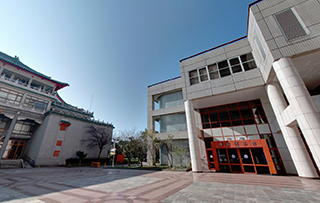
2019
Loaned Professor Chen Chih-chu’s artifacts (i.e., Wang Yiting’s “Quails and Chinese Trumpets”; Wang Yun’s “Tea Garden in Ink Wash Painting”; and Xie Gongzhan’s “Florist’s Daisies”) to the Asian Civilisations Museum (in Singapore) for its exhibition originally scheduled to be held from November 8, 2019 to March 22, 2020 (the exhibition was postponed to July 28, 2020 because of the COVID-19 epidemic); and published catalogue Living with Ink.
Interviewed by National Treasure Files (of the Beautiful Life Television) for the Lang Jingshan and Chang Dai-chien Art Exhibition, with the interview being premiered on television on December 26, at 11:00 p.m.
2018
Received 16 intriguing bowls donated by Arty Design Taiwan; and held the Art in Bowl: Arty Design Taiwan’s Trip View Bowl Exhibition on the third floor.
Hosted the Chang Dai-chien, Pu Ru, and Prince’s Descendant: Pu Ru Calligraphy and Painting Exhibition, the most complete Pu Ru exhibition curated by the Hwa Kang Museum in recent years; and published Selections from the Permanent Collection of Hwa Kang Museum XXI: Calligraphy and Painting Works of Pu Ru.
Promoted the “Treasured Artifact Collection in My House” Replica Painting Exhibitions in Communities Project, with the first exhibition being held in the Yangming Activity Center. Subsequent exhibition locations included the Floriculture Experiment Center (2019), Shilin Public Assembly Hall (2020), Xinhai Guangfu Building (2020), and SoL Art Space (2020).
2017
Received 19 artifacts (including ink wash paintings, calligraphy, oil paintings, and seal carvings) donated by Wang Zelu’s family; organized exhibition The Hwa Kang Spirit: Exhibition of Donated Works by Professor Wang Zelu and Those in the Collection of the Hwa Kang Museum; and published Selections from the Permanent Collection of Hwa Kang Museum XX: Donated Works by Professor Wang Zelu and Those in the Collection of the Hwa Kang Museum.
Xinhua News Agency reporter Wang Wen-chi interviewed Director Liu Mei-chin. The interview was broadcasted on Insight (name of show: “Cultural Treasures in the Ivory Tower”) on May 18 (i.e., the International Museum Day), introducing the Hwa Kang Museum and releasing the statement: “A great university must have a great museum.”
Lent Au Ho-Nien’s painting and calligraphy to the National Museum of Classic Books for its Chinese Culture in China and Taiwan: Au Ho-Nien Calligraphy and Painting Exhibition held between November 20 and December 31.
2016
Received 15 artifacts (consisted of Dunhuang murals created by Chang Dai-chien and Sun Chia-chin) donated by Professor Sun Chia-chin and his wife Chao Jung-nai; curated the Da-feng-hsian-chuan—Exhibition of the Works and Donated Works by Professor Sun Chia-chin; and published Selections from the Permanent Collection of Hwa Kang Museum XIX: Da-feng-hsian-chuan—Exhibition of the Works and Donated Works by Professor Sun Chia-chin.
Loaned Wu Xue-rang’s works to several institutions for their exhibitions; namely, Soka Cultural and Educational Foundation (2016/01/06-2016/12/24), Yilan Museum (2017/12/03-2018/02/12), National Taiwan Museum of Fine Arts (2017/02/18-05/07), and Chungshan National Gallery, National Dr. Sun Yat-sen Memorial Hall (2017/08/17-2017/09/27).
2015
Received an artifact donation from alumna Wu Cheng-cheng, who donated more than 600 artifacts from her American husband John L. Harbaugh’s artifact collection; held the opening ceremony for the Treasures Donated by the Harbaughs exhibition held on April 9; and published Selections from the Permanent Collection of Hwa Kang Museum XVII: John L. Harbaugh’s Precious Treasures.
Amended the Operational Procedure of the Hwa Kang Museum, Chinese Culture University.
Formulated Guidelines for Establishing Collection and Review Teams at the Hwa Kang Museum, Chinese Culture University.
Introduced Guidelines for the Collection of Artifacts at the Hwa Kang Museum, Chinese Culture University.
2014
Professor Liu Mei-chin was appointed as the museum director (since 2014).
The Hwa Kang Museum performed its first inventory check on its 77,000+ art artifacts.
Lent painting and calligraphy to the Museum de Arte de Macau for The Bold Brush of Au Ho-Nien exhibition held from June 25 to August 31.
2013
Lent Fu Shen’s works to the National Museum of China in Beijing for its The Solo Exhibition of Fu Shen. Said exhibition was subsequently held in the National Museum of History in July 2014.
Authorized digital images of the Hwa Kang Museum’s artifacts to be used to develop merchandise at institutions such as Danee, the Land Bank of Taiwan, and Academia Sinica Center for Digital Cultures following the Cultural and Creative Product Interdisciplinary Innovation Project introduced by the Ministry of Culture; the results were published in the 2014 calendar and Issue No. 4 of the Digital Cultures Newsletter.
Co-hosted the First Professional Museum Training Workshop and a comprehensive seminar with the Bei Shan Tang Foundation and The Chinese University of Hong Kong, inviting outstanding museum personnel from Taiwan and China to participate in the events.
Professor Wu Rui-xiu was appointed as the museum director (2013-2014).
From October to December, 2013, co-hosted the Taipei: City of Learning: Culture Laboratory event with the Department of Cultural Affairs, Taipei City Government, connecting 22 art and cultural centers and 20 privately run art and cultural institutions to organize over 180 exhibitions, courses, seminars, and marketing activities.
2012
The Hwa Kang Museum presented Chronology of the Founder on the seventh floor in the Library on March 1.
An Exhibition of Zhang Shuqi’s Chinese Paintings and Works was held at the Three Gorges Museum in Chongqing, China, exhibiting 40 of Zhang’s works in the collection of said museum.
On May 7, Chang Jen-hu and Chen Jun (president of the Nanjing University) unveiled the Chang Chi-yun Outstanding Alumni Gallery at the History Museum, Nanjing University (Xianlin Campus). More than 30 teachers and alumni were in attendance.
Hosted the Zhang Shuqi Exhibition at the Zhejiang Art Museum.
Professor Chi Jo-hsin was appointed as the museum director (2012-2013).
From August 10 to September 29, co-hosted the Sun To-Ze Centennial Memorial Exhibition (with the National Museum of History as the exhibition host); and held the exhibition opening ceremony on Aug. 16.
Received 56 Chinese artifact donations comprising ancient ceramics and white jades from Tseng Shui-chao, the president of Grape King Bio.
Formulated Fee Collection Guidelines for the Use of Artifact Images Authorized by the Hwa Kang Museum, Chinese Culture University.
Co-hosted the Works of Art from the Hills and Pastures — A Special Exhibition of Mongolian and Tibetan Folk Art on Campus with the Mongolian and Tibetan Affairs Commission, exhibiting Mongolian and Tibetan festivals and artifacts.
2011
Professor Wu Jui-hisu was appointed as the museum director (2011-2012).
2005
Co-hosted the The Sounds of Painting and Calligraphy: Puru’s Painting and Calligraphy Exhibition with the Prince Kung’s Mansion Management Center of the Ministry of Culture in China. The exhibition was held at Prince Kung’s Mansion.
2004
Founded the Au Ho-Nien Art Center.
Received subsidy from the Council for Cultural Affairs (for the (National Cultural Database Project) and began planning the digital collection project.
Was awarded the National Digital Collection Project by the National Science Council in 1993, 1994, 1995, 1997, and 1999, receiving their subsidies; and built more than 1,000 digital artifact images and metadata.
2002
Professor Au Ho-Nien donated 100 painting and calligraphy.
2000
Curated and held special exhibition Masterpieces of Western Paintings from the Renaissance to the 20th Century on behalf of the university at the National Dr. Sun Yat-sen Memorial Hall, exhibiting artifacts in the collection of the Tokyo Fuji Art Museum; and trained exhibition tour guides.
Submitted an application to the Council for Cultural Affairs (of the Executive Yuan) for the Third Arts & Business Awards on behalf of the university, ultimately winning the award.
1999
The new Hwa Kang Museum building was official open for operation in celebration of the 37th anniversary of the university.
Professor Chen Ming-hsiang was appointed as the museum director (1999-2011).
1998
Completed the building of the museum and organized and relocated its artifacts.
The Hwa Kang Museum received the Social Education Promotion Award issued by the Ministry of Education.
The Council for Cultural Affairs (now Ministry of Culture), Executive Yuan hosted the Special Exhibition of Chinese Musical Instruments at the Taipei News and Cultural Center, Paris, France. The Department of Chinese Music of the university accompanied the Council of Cultural Affairs to deliver performances in Paris.
Curated special exhibition Masterpieces of Japanese Art from the Momoyama Period to the Modern Period held by the university at the National Dr. Sun Yat-sen Memorial Hall, exhibiting artifacts in the collection of the Tokyo Fuji Art Museum; trained exhibition tour guides; and performed exhibition maintenance operations.
1996
Lang Jingshan’s wife Yang Hui-ya donated 23 painting and calligraphy created by famous painters and calligraphers to commemorate the 104th birthday of the late Lang Jingshan.
1993
Professor Hui Yi-han of the Drama Department of the university donated 31 ink wash paintings created by Tang Shi-xia, a royal family member in the late-Qing dynasty.
1992
Co-hosted a teacher-student calligraphy exhibition with the Beppu University to celebrate the two universities becoming sister universities on Dec. 12, 1990. The exhibition was first held in Beppu, Japan from January 3 to 7, and later in the Hwa Kang Museum from February 29 onwards. Chang Jen-hu, his wife Mu Min-zhu, Lin Tung (senior executive officer of the Bureau of International Cultural and Educational Relations, Ministry of Education), Nishimura Shunichi (chairman of the Beppu University, Japan), Goto Shigemi (minister of literature, Japan), Nonaka Taku (junior college minister, Japan), and Kudo Shigeru (director of the Institute of Asian Cultural Studies, Japan) co-participated in the ribbon-cutting ceremony.
The Pu Xiaohua Remnant Management Team, represented by Chou Hui-ying, transferred Puru and Yao Zhaoming’s painting and calligraphy to the Hwa Kang Museum, and asked the museum to look after them temporarily; and donated more than 2,000 of Yao Zhaoming’s artifacts as well as painting and calligraphy.
1985
Because of the increasing number of artifacts and various facilities urgently in need of renovation, new buildings were constructed following the instructions of Chang Jen-hu, chairman of the board of directors of the university. Additionally, the Hwa Kang Museum, Library, and Information & Communication Center were merged into the Xiaofeng Memorial Hall.
1980
Lin Chun-wei, a teaching assistant of the College of Printing and Communication of the university, donated over 200 Banqiao Lin Family artifacts including Qing dynasty furniture and pottery urns.
1979
Wang Zelu donated 40 contemporary painting and calligraphy created by famous painters and calligraphers.
1977
Chen Zhi-chu donated 36 painting and calligraphy created by famous painters and calligraphers from the Qing dynasty to early-Republic of China period.
1975
Teng Chang-kuo, former director of the College of Arts of the university, donated 12 volumes of his late father Teng Chih-yuan’s birthday congratulation-related poetry, painting, and calligraphy (totaling 1,197 works).
Lu Chung-kuan and Mei Lin-kao donated 17 and five painting and calligraphy created by famous painters and calligraphers, respectively.
Professor Chen Kuo-ning was appointed as the museum director (1974-1999).
1972
Professor Chao Chen-chi was appointed as the museum director (1972-1974).
Lang Jingshan donated a total of 69 artifacts including his calligraphy works; Yu Youren’s calligraphy; and painting and calligraphy created by a painter from Xi’an, China to congratulate Lang’s birthday.
1971
The Hwa Kang Museum was officially established on the sixth floor in the Dayi building, becoming the first museum opened by a comprehensive university in Taiwan. Professor Pan Wei-ho was appointed as its director, and six departments (i.e., the Exhibition, Collection, Solicitation, Editing, Photography, and Service Departments) were created for the museum.
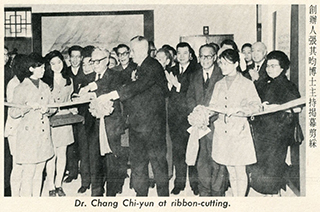
圖片來源:《美哉中華》,文化學院編輯部,第27期,民國60年1月,頁20。

圖片來源:《美哉中華》,文化學院編輯部,第34期,民國60年8月,頁18。
1970
Professors Shih Tsui-feng and Pan Wei-ho actively prepared for the opening of the Hwa Kang Museum.
1969
Phase 3 of artifact collection and museum preparation: On August 26, 1969, organized The First International Conference on Chinese Studies. In the following year, the exhibition items were gathered, ultimately giving birth to the International Conference on Chinese Studies Exhibition Hall. Professor Pan Wei-ho was appointed as its director, marking the beginning of phase 3 of artifact collection and museum preparation.
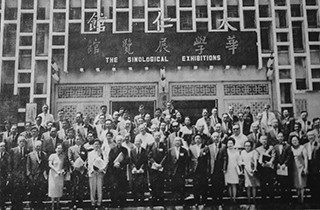
Zhang Shuqi’s wife Fang Yimin donated 40 of Zhang’s ink wash paintings.
1968
Lang Jingshan continued to donate his photography works, totaling more than 200.
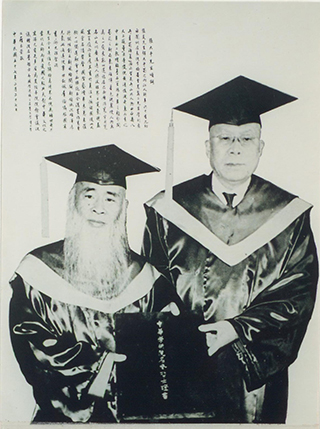
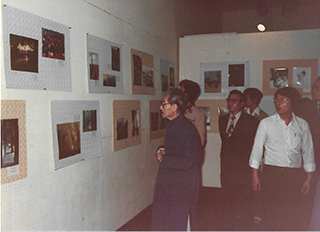
1966
The university established “The China Academy” and began bestowing the title “honorary philosopher,” which facilitated most of the artifact donations received by the university in the early days. For example, in 1968, Chang Dai-chien was bestowed said title, and Chang Chi-yun wrote “Complimentary Address to Mr. Chang Dai-chien.”
Former Taipei City Mayor Yu Mi-chien donated 27 pastel paintings and 21 oil paintings of The Palace Museum buildings created Russian painter N. Pickulevitch (?-1965). When former president Chiang Kai-shek visited the university on Mar. 20, 1966, he borrowed them from the university so that he could view them in his free time (the oil paintings were later returned to the university). Additionally, President Chiang instructed to have “Zigong Going on a Trip” (donated by Tseng Hou-hsi) relocated to the Chungshan Hall reception room, and “Sun Yat-sen and Chiang Kai-shek” (created by Chen Tzu-shan) hung inside the National Palace Museum in Waishuanghsi.
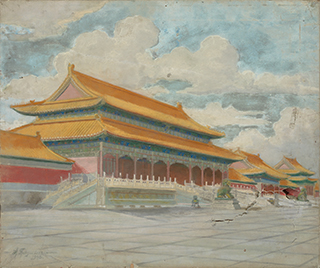
1965
Phase 2 of artifact collection and museum preparation: Raised the Da Ren building, with the Artifact Museum being established on its fifth floor and Professor Song Xi being appointed as its director; and hosted the Late Sun Yat-Sen 100th Birthday Memorial Exhibition, where the exhibition items were incorporated into the collection of the Chinese Artifact Exhibition Hall after the exhibition.
1962
Phase 1 of artifact collection and museum preparation: Celebrated the first anniversary of the Chinese Culture University (hereafter referred to as “the university”) and built the Da Cheng building, the first building of Hwa Kang. The Chinese Artifact Exhibition Hall was constructed, and Professor Sun Tang-yueh was appointed as its director. According to Records on the Completion of the Da Cheng Building, “The objectives are to integrate the efforts made by honorable individuals since the Republic of China period; facilitate a Chinese renaissance; unite science, industrialization, and modernization together; expose the Chinese and foreign public to Chinese culture; and have these ‘intangible’ endeavors create ‘tangible’ effects.” The Central Daily News later released a news report, commenting that a foundation was built facilitating a Chinese renaissance.
On Mar. 9, 1963, Chang Chi-yun, the founder of the Hwa Kang Museum, hosted the Chinese Artifact Exhibition Hall opening ceremony. More than 400 guests including Tang Zong, Ni Wenya, Luo Jialun, Zeng Yuenong, Zeng Baosun, Zheng Yanfen, Huang Zhengming, Zeng Xubai, and Jiang Fucong attended the event. Chang Chi-yun published The Objectives of the Chinese Artifact Exhibition Hall, introducing the following objectives: “1. Promote modern Chinese culture; 2. Study for the purpose of application; 3. Introduce new ideas; 4. Complement the tangible with the intangible, and vice versa; 5. Make extensive searches; and 6. Gain new insight through restudying old materials.” Chang hoped that by the late Sun Yat-sen’s 100th birthday, the Chinese Artifact Exhibition Hall “will have flourished both in its software and hardware, becoming a literary resource venue as well as a tourist attraction.”